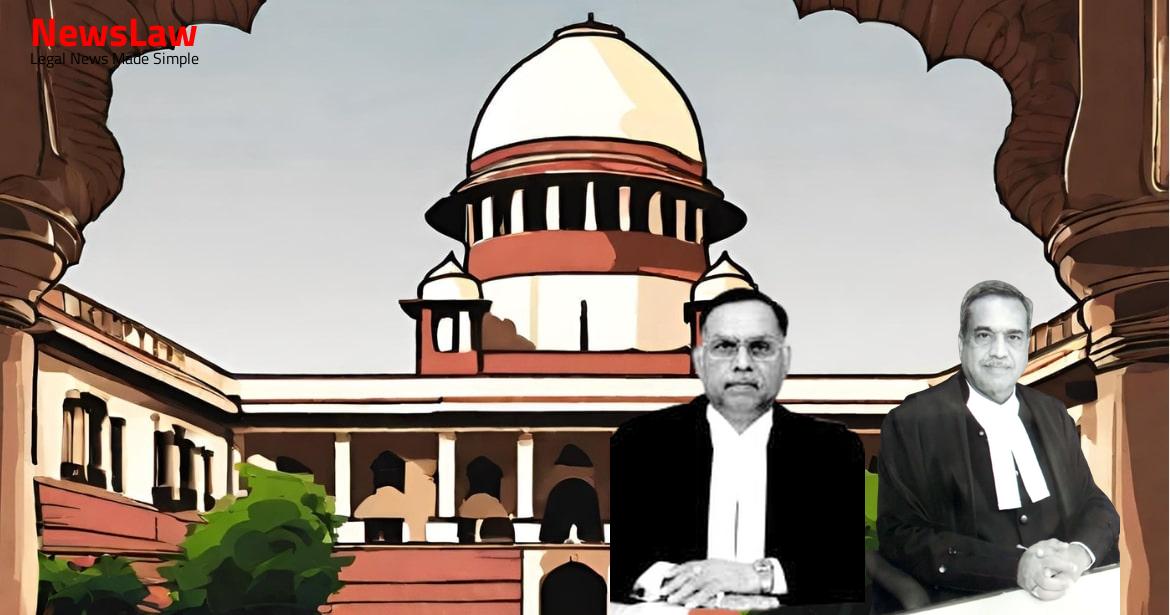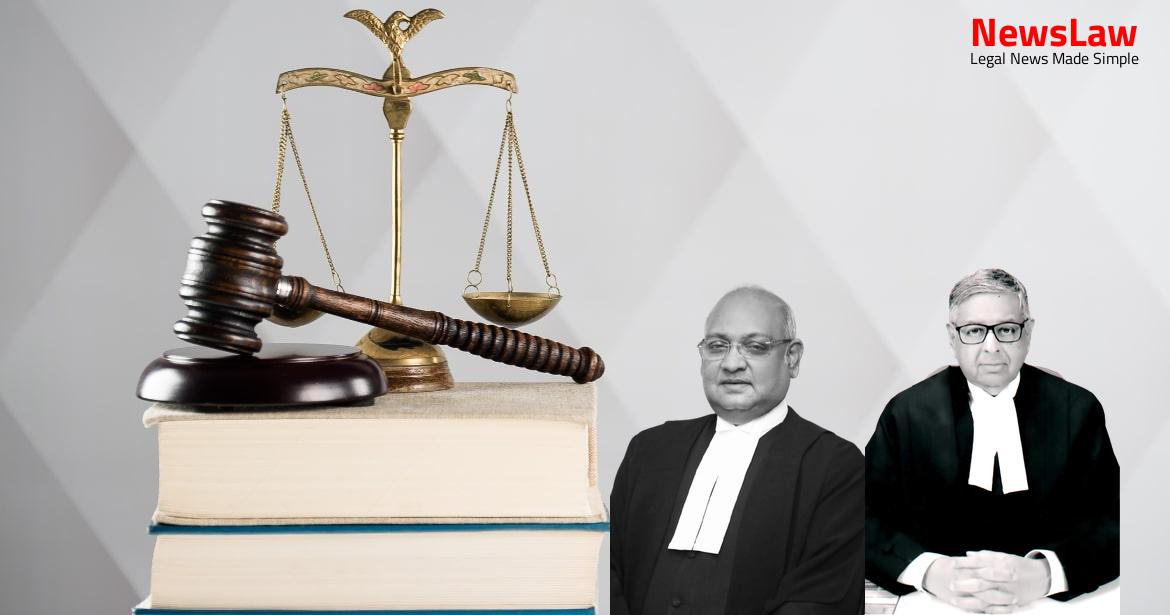Explore the critical role of circumstantial evidence in a recent court judgment, where the court meticulously evaluated witness accounts, recovered items, and the presence of common intention among the accused. This analysis underscores the challenges and nuances involved in proving guilt in criminal cases based on circumstantial evidence. Follow along to understand how legal principles and evidentiary considerations shape the outcome of complex criminal trials.
Facts
- The incident of loot took place on 08.09.2008 in the deceased’s house while she was alone.
- Postmortem confirmed the prosecution’s case.
- The appellant and others were found guilty under Sections 11 and 13 of the Madhya Pradesh Adhiniyam.
- The appellant was sentenced to 10 years Rigorous Imprisonment under Section 460 of the IPC.
- He also received a sentence of 10 years for the offence under Section 394 read with Section 34 of the IPC.
- The appellant, along with 4 others, were convicted under Sections 394, 460, and 302 read with Section 34 of the IPC.
- He was further found guilty of offences under Sections 11 and 13 of the Madhya Pradesh Dakaiti Avam Vyapharan Adhiniyam, 1981.
- Initially sentenced to death, the High Court commuted it to life imprisonment and increased the fine to Rs. 25,000/-.
- Stolen property and weapon seized on the statement of the accused completed the chain of circumstantial evidence.
- Certain articles found missing from the deceased’s house.
- Identification of gold and silver jewelry and mobile phones belonging to the deceased.
- Deposition by PW5 about overheard conversation between the accused regarding criminal conspiracy.
- All three accused present at the place of occurrence committed the murder and loot together.
- Accused did not produce evidence in rebuttal indicating common intention to commit murder.
- Nature of wounds on the deceased suggested homicidal death.
- Neeraj Bhargava informed PW9 about deceased not responding.
- Recovery of weapon from accused Kalli, necklace from Virendra, and earrings from Veeru.
- Statements from witnesses recorded, cyber cell details received for stolen mobile sets.
- Identification proceedings conducted to identify seized/recovered articles.
- Trial court found it to be a case based on circumstantial evidence with injuries on the deceased suggesting murder.
Also Read: Analyzing Legal Reasoning in a Poisoning Death Case
Issue
- The specific issue in the judgement is whether accused individuals, namely Kalli @ Gopal Sharma, Sonu @ Sunil, and Hariom, committed the murder of Bharosilal after committing house trespass in his residential house.
- The Trial Court questioned whether the accused individuals entered Bharosilal’s house after sunset and before sunrise, and then proceeded to commit murder.
- The focus of the issue is on the actions of the accused on the specific date of the incident in relation to house trespass and murder in Bharosilal’s residential property.
Also Read: Interplay of CrPC and Drugs Act: Legal Analysis
Arguments
- PW-5’s alleged overhearing of the conversation between the accused is highly improbable.
- Learned Senior Counsel argues lack of evidence against the appellant for the convicted offences.
- Complaints about the reliance placed on PW-5 by the lower courts.
- Defense counsel argues that PW-5’s testimony is not credible.
- PW-1’s testimony did not align with the version attributed to him by the prosecution.
- Clear discrepancy highlighted in the recovery of the mobile phone from the appellant.
- Memorandum states that the appellant took a Nokia mobile phone belonging to the deceased and hid it on the roof of his house.
Also Read: Analysis of Hindu Joint Family & Succession Laws
Analysis
- Recovery of a knife from the accused Kalli was significant but insufficient evidence to convict based solely on this recovery
- The recovery of a mobile phone from the appellant was based on a statement given by him while in custody
- Issues arose regarding the ownership of the seized mobile phone, as it did not match the number provided by the deceased’s son
- Various circumstantial evidence and witness testimonies were considered to link the accused to the crime
- The identification of stolen goods, including mobile phones, played a crucial role in the case
- The recovery of items like a gold khanti and a silver plate added to the prosecution’s case
- The prosecution relied heavily on circumstantial evidence and witness accounts to establish guilt
- Questions were raised about the validity of the identification procedure for the recovered items
- Doubts were cast on the prosecution’s case due to discrepancies in testimonies and lack of concrete evidence in some instances
- The timing and manner of the theft and murder were key factors in determining the accused’s involvement
- In the case of Hardev Singh and others v. State of Punjab, the Court clarified that for a person to be guilty of a crime with the aid of Section 34 of the Penal Code, there must be a common intention to commit the particular crime.
- The Court emphasized that direct proof of common intention is difficult, and it can only be inferred from the circumstances and acts of the parties involved.
- The mere possession of stolen property after a crime does not automatically make a person guilty of the crime; the inference of guilt must be based on clear evidence.
- The nature of the stolen article, manner of acquisition, actions of the accused, and ability to explain possession are all factors considered in drawing a presumption of guilt.
- The possession of stolen goods soon after a crime provides a strong basis for presumption of guilt unless the accused can provide a consistent explanation for the possession.
- For vicarious liability under Section 34 of the Penal Code, the court must establish a prior common intention among all involved parties based on their conduct and incriminating evidence.
- In order to establish common intention under Section 34, a meeting of minds and fusion of ideas among accused must be proven beyond doubt.
- If doubt exists regarding the involvement of a particular accused in common intention, the benefit of doubt should be given to that accused.
- Prosecution must demonstrate through evidence a plan or meeting of minds of all accused to commit the offense they are charged with under Section 34.
- Evidence relied upon for establishing common intention should be clear, direct, or circumstantial.
- The lack of clarity in evidence, discrepancies, and absence of the accused from significant events may raise doubts about their involvement.
- Conducting a Test Identification Parade could have been beneficial to establish the accused’s association with the crime.
- In cases where evidence is inconclusive or ambiguous, it may not be safe to uphold the conviction of the accused.
Decision
- The impugned judgment in so far as it relates to the appellant has been set aside.
- The appellant will stand acquitted.
- The appellant’s bail bond shall stand discharged.
Case Title: SONU @ SUNIL Vs. THE STATE OF MADHYA PRADESH (2020 INSC 409)
Case Number: Crl.A. No.-000057-000057 / 2013



